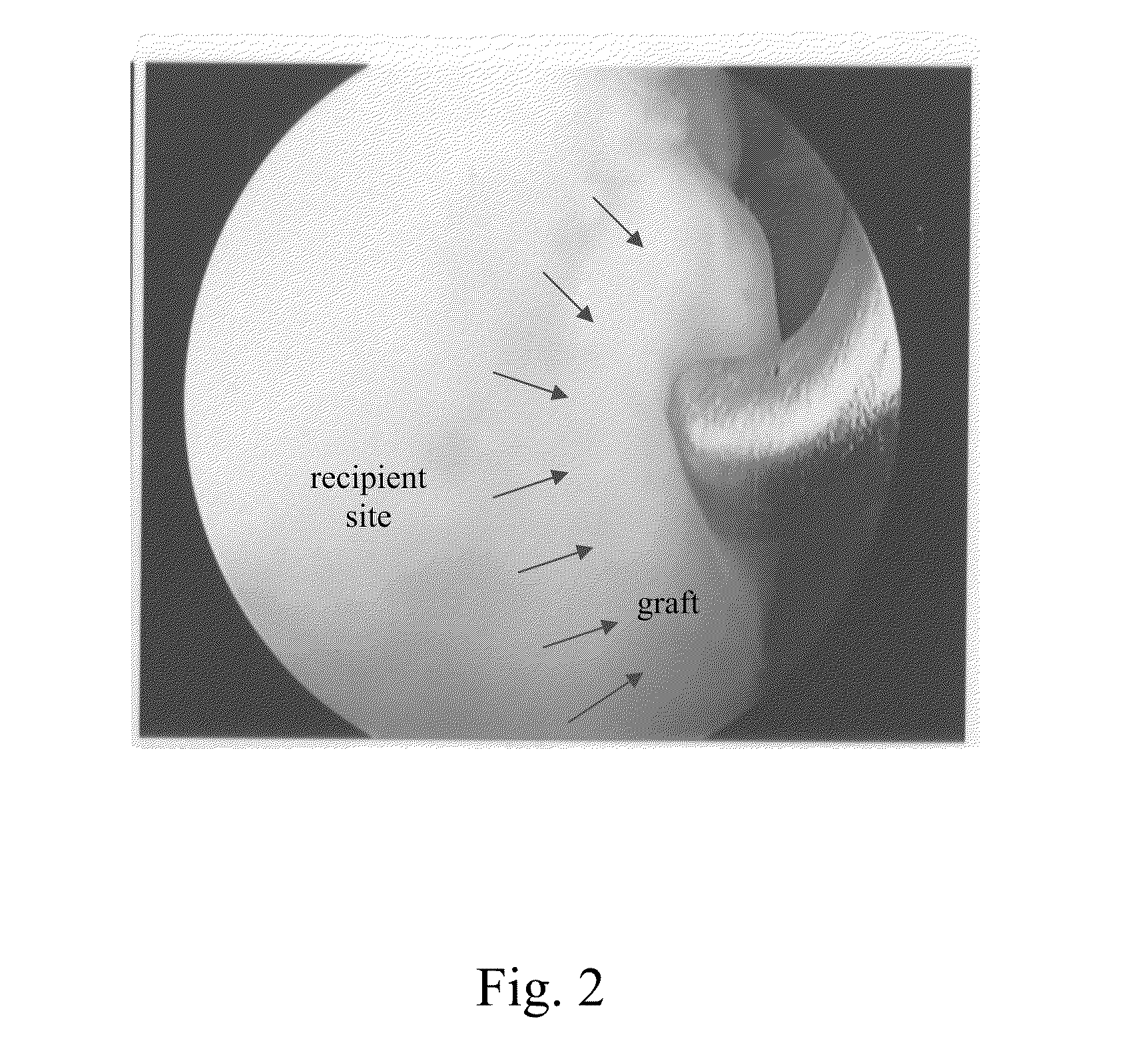Surgical grafts for repairing chondral defects
a chondral defect and surgical graft technology, applied in the field of surgical grafts for repairing chondral defects, can solve the problems of limited autogenous chrondrocyte sources, low proliferation ability of chondrocytes, and loss of unique phenotypes
- Summary
- Abstract
- Description
- Claims
- Application Information
AI Technical Summary
Benefits of technology
Problems solved by technology
Method used
Image
Examples
example 1
Isolation and Culture of Human MSCs
[0034]Ten (10) ml of heparinized bone marrow blood was aspirated from the ilium of the pelvis, and bone marrow MSCs were isolated therefrom. The MSCs were cultured in Dulbecco's modified Eagle's medium with low glucose containing 10% fetal bovine serum at 37° C. under 5% carbon dioxide and 95% humidity. The medium was changed twice a week. The cells were trypsinized and subcultured at a ratio of 1:3 every week, and then harvested and embedded in Porcogen™ collagen solution (3% type-I / type-III collagen, SunMax Biotech., Taiwan) containing serum-free DMEM-LG only. The cells were cultured at 0.5 mL aliquots with a final cell density of 2.6×106 cells / cm2 to gel in 24-well plates at 37° C. for 1 hour followed by the addition of 2.0 mL medium per well containing: serum-free DMEM-LG containing ITS+ Premix, 50 ug / mL L-ascorbic acid-2-phosphate, 10−7 M dexamethasone, supplemented with 10 ng / mL TGF-β1 (Pepro Tech; Rocky Hill, N.J.). The cells were cultured i...
example 2
Characterization of the Cell-Matrix Complex
[0035]The cell-matrix complexes were harvested, embedded in paraffin and cut into 5 μm slices. The slices were deparaffinized, and rehydrated by sequential immersion in 100% xylene, 100% ethanol, 70% ethanol, and water. Hematoxylin and eosin staining (Muto, Tokyo, Japan) of sample sections was used to evaluate the cell morphology. In addition, Alcian Blue staining (Sigma) was used to evaluate the glycosaminoglycan (GAG) content.
example 3
Investigation on Human Patients
[0036]1. Patient Populations
[0037]Patients with chondral or osteochondral defects from osteochondritis dissecans or osteonecrosis of medial femoral condyle, or limited chondral defects of osteoarthritis which was located on the weight-bearing site were selected. However, patients with immature bone, severely degenerative arthritis in which total joint arthroplasty is needed, other defects such as cruciate ligament rupture and meniscus injury, arthritis such as rheumatoid arthritis and gouty arthritis, and infectious disease such as AIDS and Hepatitis B; patients completely bed-ridden above three months; patients taking corticosteroids longer than two weeks, and alcoholism are excluded. Totally, 10 patients were recruited. Among them, six were female and four were male. The patients' average age was 66 (ranging from 47 to 83).
[0038]2. Operation
[0039]An anterior midline incision was made on the knee and the articular surface of the medial femoral condyle...
PUM
| Property | Measurement | Unit |
|---|---|---|
| Fraction | aaaaa | aaaaa |
| Time | aaaaa | aaaaa |
| Concentration | aaaaa | aaaaa |
Abstract
Description
Claims
Application Information
 Login to View More
Login to View More - R&D
- Intellectual Property
- Life Sciences
- Materials
- Tech Scout
- Unparalleled Data Quality
- Higher Quality Content
- 60% Fewer Hallucinations
Browse by: Latest US Patents, China's latest patents, Technical Efficacy Thesaurus, Application Domain, Technology Topic, Popular Technical Reports.
© 2025 PatSnap. All rights reserved.Legal|Privacy policy|Modern Slavery Act Transparency Statement|Sitemap|About US| Contact US: help@patsnap.com


